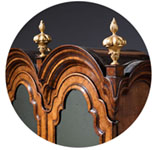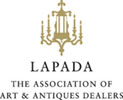17th Century William and Mary Marquetry Longcase Clock, Signed Apply
Sold
Request Information
Follow Us
17th Century William and Mary Marquetry Longcase Clock, Signed Apply
A wonderful late seventeenth-century rising hood 10-inch William and Mary eight-day floral marquetry olive oyster longcase clock by Edmund Appley, London, c. 1680-1685.
The attractive and fine olive oyster-veneered case is of the highest quality and decorated throughout in floral and leaf marquetry depicting spring flowers, a bird and scrolling foliage, each on a ground of ebony within a panel bordered with boxwood.
The trunk door reflects the ebonised mouldings and pillars on the hood and is bordered by an ebonised D-moulding with a circular lenticle set within an ebonised moulding. The rising hood is decorated with fine scrolling blind fretwork and cavetto moulding, flanked by tapering ebonised barley-twist columns. Large linear viewing windows of glass sit to each side of the hood.
The cross-banded sides have been carefully thought out too, with small sections of saw-cut olive oyster veneer, each carefully book-matched.
Raised on four ebonised bun feet.
The whole case is of extremely good colour and has the most lovely age-patinated surfaces.
The eight-day five pillar movement has going and striking trains. The striking train is regulated by an inside countwheel (the detent mounted externally and engaging through a slot in the backplate). The going train has anchor escapement with bolt and shutter maintaining power and a seconds pendulum. The backplate is mounted with a brass L-shaped bracket located against a conforming iron bracket set into the backboard.
The 10-inch brass dial has a solid silver chapter ring, seconds ring and date aperture. A wonderful sign of quality. The silver chapter ring is divided into Roman hour numerals as well as quarter-hour, fleur-de-lys half-hour, Arabic five-minute and minute divisions. It is surrounded by solid silver winged cherub-head spandrels in the corners and is signed along the bottom of the brass plate “Edmund Appley Charing Cross”. The centre is finely matted, showing the shutters in a closed position, whilst the time is indicated by a fine pair of richly pierced blued-steel hands.
The maker
Edmund Appley was born the son of Humphrey Appley, a weaver, in 1656. He was apprenticed to Jeffrey Bayley in 1670 and made free in London in 1677. From 1681 he took apprentices himself, working in Charing Cross. He died on a visit to Edinburgh in 1688 and was buried there. Longcase clocks, bracket clocks and lantern clocks by his hand are known.
Height 198 cm with a height of 225 cm with the hood raised to wind.
Condition
Good. Wear consistent with age and use.
Dimensions
Height: 198 cm (77.96 in)
Width: 39 cm (15.36 in)
Depth: 22.5 cm (8.86 in)
PREVIOUSLY SOLD
No Results Found
The page you requested could not be found. Try refining your search, or use the navigation above to locate the post.
No Results Found
The page you requested could not be found. Try refining your search, or use the navigation above to locate the post.
YOU MAY ALSO LIKE
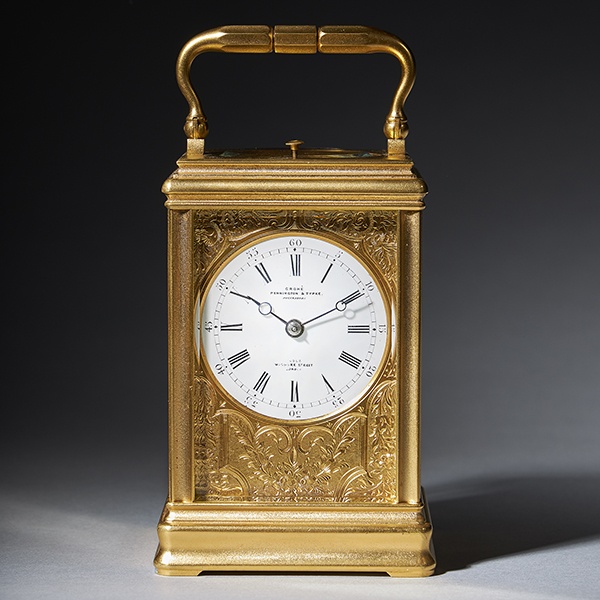
19th Century Repeating Gilt-Brass Carriage Clock by the Famous Drocourt
19th Century Repeating Gilt-Brass Carriage Clock by the Famous Drocourt £5,600 Follow Us19th Century Repeating Gilt-Brass Carriage Clock by the Famous Drocourt A superb repeating carriage clock with a gilt-brass gorge case by the famous maker...
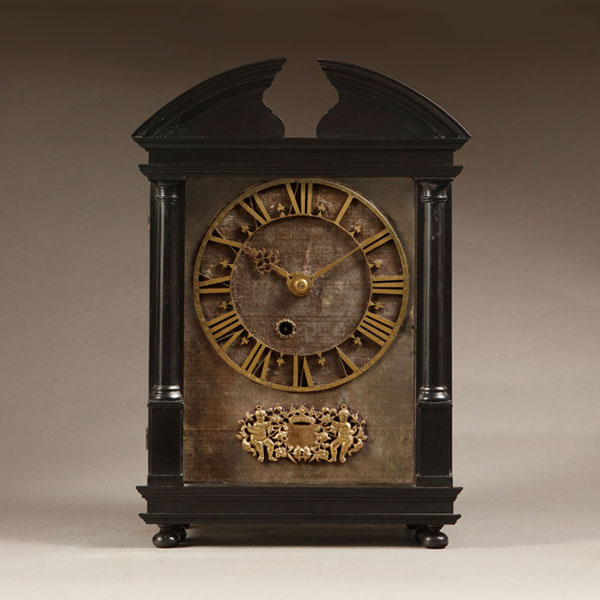
17th-Century Hague Clock Signed by Pieter Visbagh, circa 1675
Small 17th Century Hague clock made c. 1675 by Pieter Visbagh, who was apprenticed by Salomon Coster. The latter made the first pendulum clock according to the instructions of Christiaan Huygens, the internationally renowned scientist who developed the idea of applying a pendulum to a clock movement.
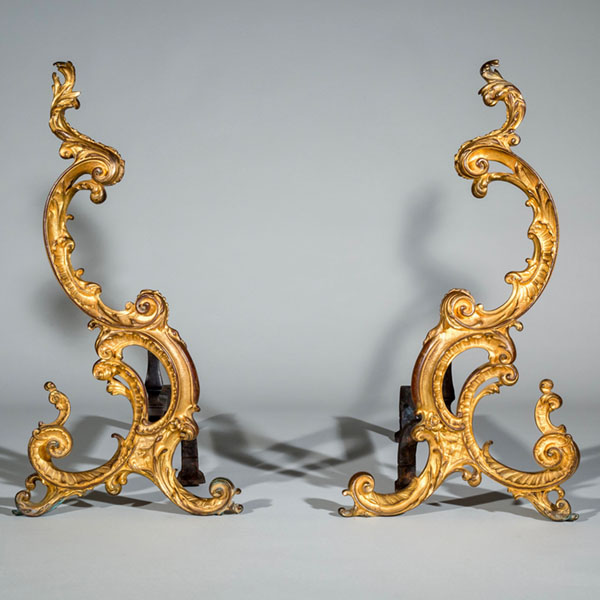
Pair of 18th-Century English Rococo Gilt Bronze Andirons or Firedogs
An exceptional pair of 18th century English Rococo gilt bronze andirons or fire dogs.
The bold shape of these andirons relate to designs of Thomas Johnson (1714–1778), one of London’s pioneers of the ‘Modern’ or French style, later known as Rococo.
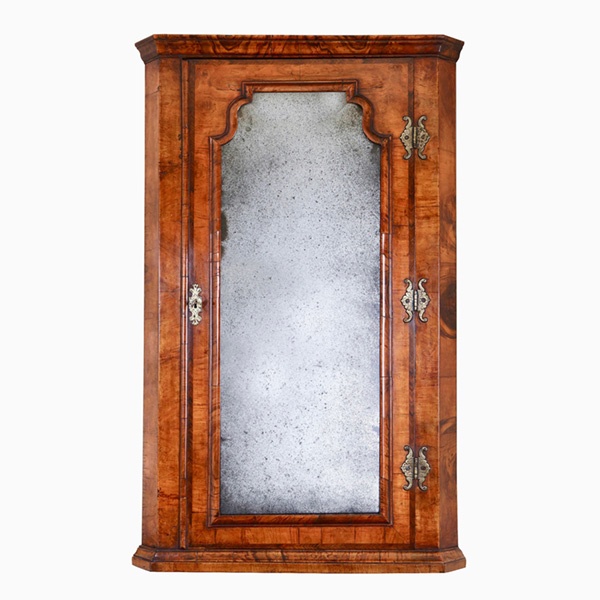
Queen Anne Walnut Corner Cupboard with Bevelled Mirror Plate
A truly remarkable find in original condition. To the door a shaped soft bevelled mirror plate is framed by a cross-grain molding of typical queen Anne design which is further cross-banded, feather-banded and edged to the opening with a single de-molding.

19th Century Repeating Gilt-Brass Carriage Clock by the Famous Drocourt
19th Century Repeating Gilt-Brass Carriage Clock by the Famous Drocourt £5,600 Follow Us19th Century Repeating Gilt-Brass Carriage Clock by the Famous Drocourt A superb repeating carriage clock with a gilt-brass gorge case by the famous maker...

17th-Century Hague Clock Signed by Pieter Visbagh, circa 1675
Small 17th Century Hague clock made c. 1675 by Pieter Visbagh, who was apprenticed by Salomon Coster. The latter made the first pendulum clock according to the instructions of Christiaan Huygens, the internationally renowned scientist who developed the idea of applying a pendulum to a clock movement.

Pair of 18th-Century English Rococo Gilt Bronze Andirons or Firedogs
An exceptional pair of 18th century English Rococo gilt bronze andirons or fire dogs.
The bold shape of these andirons relate to designs of Thomas Johnson (1714–1778), one of London’s pioneers of the ‘Modern’ or French style, later known as Rococo.

Queen Anne Walnut Corner Cupboard with Bevelled Mirror Plate
A truly remarkable find in original condition. To the door a shaped soft bevelled mirror plate is framed by a cross-grain molding of typical queen Anne design which is further cross-banded, feather-banded and edged to the opening with a single de-molding.
